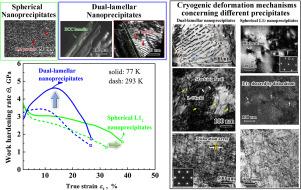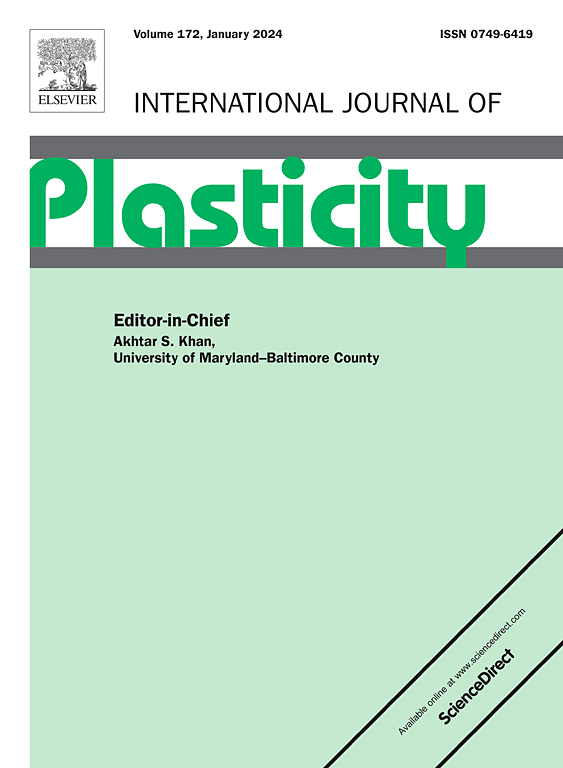Tailoring multi-type nanoprecipitates in high-entropy alloys towards superior tensile properties at cryogenic temperatures
IF 9.4
1区 材料科学
Q1 ENGINEERING, MECHANICAL
引用次数: 0
Abstract
In this work, the quasi-static tensile properties in the face-centered cubic-based Al0.5Cr0.9FeNi2.5V0.2 HEAs containing two types of heterogeneous nanoprecipitates, i.e., dual-lamellar and spherical nanoprecipitates, at ambient (293 K) and liquid nitrogen (77 K) temperatures are thoroughly investigated. The microstructure formed by aging at 873 K comprises L1 and body-centered cubic dual-lamellar (DL) nanoprecipitates. In contrast, aging at 773 K results in solely spherical L1 nanoparticles. Both nanoprecipitates enhance mechanical strength as temperatures drop to 77 K; however, the DL nanoprecipitates additionally boost the work hardening rate, whereas the spherical nanoparticles notably improve ductility. To investigate the underlying deformation mechanisms, we perform interrupted mechanical tests and microstructure characterizations at various strains. The DL nanoprecipitates are observed to go through a multistage work hardening rate response by gradually introducing new boundaries to block dislocation motion, activating the stacking fault (SF) networks, and forming Lomer–Cottrell locks. A combination of interface hardening, dislocation hardening, SF-induced hardening, and precipitation hardening in DL samples leads to stronger hetero-deformation-induced hardening at cryogenic temperatures. In comparison, while samples with only spherical nanoparticles exhibit a monotonous decrease in the work-hardening rate, the spherical nanoparticles can be sheared by dislocations, effectively alleviating strain concentration and thereby enhancing ductility at cryogenic temperatures. Overall, this work provides practical design principles of nanoprecipitates for fine-tuning the balance of strength and ductility in FCC-based HEAs at cryogenic temperatures.

定制高熵合金中的多型纳米沉淀物,实现低温下的优异拉伸性能
本文深入研究了面心立方基 Al0.5Cr0.9FeNi2.5V0.2 HEA 在环境温度(293 K)和液氮温度(77 K)下的准静态拉伸性能,该 HEA 含有两种类型的异质纳米沉淀物,即双层和球形纳米沉淀物。在 873 K 温度下老化形成的微观结构包括 L12 和体心立方双层(DL)纳米沉淀物。相比之下,在 773 K 下老化形成的只有球形的 L12 纳米颗粒。当温度降至 77 K 时,两种纳米沉淀物都能提高机械强度;然而,DL 纳米沉淀物还能提高加工硬化率,而球形纳米颗粒则能显著改善延展性。为了研究其潜在的变形机制,我们在不同应变下进行了间断机械测试和微观结构表征。我们观察到 DL 纳米沉淀物通过逐渐引入新的边界来阻止位错运动、激活堆积断层(SF)网络并形成 Lomer-Cottrell 锁,从而经历了多级加工硬化率响应。在 DL 样品中,界面硬化、位错硬化、SF 诱导的硬化和沉淀硬化相结合,在低温条件下产生了更强的异质变形诱导硬化。相比之下,虽然只有球形纳米粒子的样品表现出单调的加工硬化率下降,但球形纳米粒子可以被位错剪切,有效缓解应变集中,从而提高低温下的延展性。总之,这项工作为微调低温下基于催化裂化的 HEA 的强度和延展性平衡提供了实用的纳米沉淀物设计原则。
本文章由计算机程序翻译,如有差异,请以英文原文为准。
求助全文
约1分钟内获得全文
求助全文
来源期刊

International Journal of Plasticity
工程技术-材料科学:综合
CiteScore
15.30
自引率
26.50%
发文量
256
审稿时长
46 days
期刊介绍:
International Journal of Plasticity aims to present original research encompassing all facets of plastic deformation, damage, and fracture behavior in both isotropic and anisotropic solids. This includes exploring the thermodynamics of plasticity and fracture, continuum theory, and macroscopic as well as microscopic phenomena.
Topics of interest span the plastic behavior of single crystals and polycrystalline metals, ceramics, rocks, soils, composites, nanocrystalline and microelectronics materials, shape memory alloys, ferroelectric ceramics, thin films, and polymers. Additionally, the journal covers plasticity aspects of failure and fracture mechanics. Contributions involving significant experimental, numerical, or theoretical advancements that enhance the understanding of the plastic behavior of solids are particularly valued. Papers addressing the modeling of finite nonlinear elastic deformation, bearing similarities to the modeling of plastic deformation, are also welcomed.
 求助内容:
求助内容: 应助结果提醒方式:
应助结果提醒方式:


